■ Mohammed Al-Hakimi *
On his wooden boat, the fisherman Abdu Ahmed (25 years) clings to the profession of fishing, as it is the only source of income for his 7-member family. Moving towards the fishing areas, Abdu is all fears to face any troubles that might impede his only source of livelihood. Those fears are also shared with all fishermen working along the Yemeni coast.
Speaking to Holm Akhdar, Abdu Ahmed says, “Our entire livelihood is from the sea. If the sea is gone, where should we go? We did not receive any education to get another job. We have nothing but the sea.”
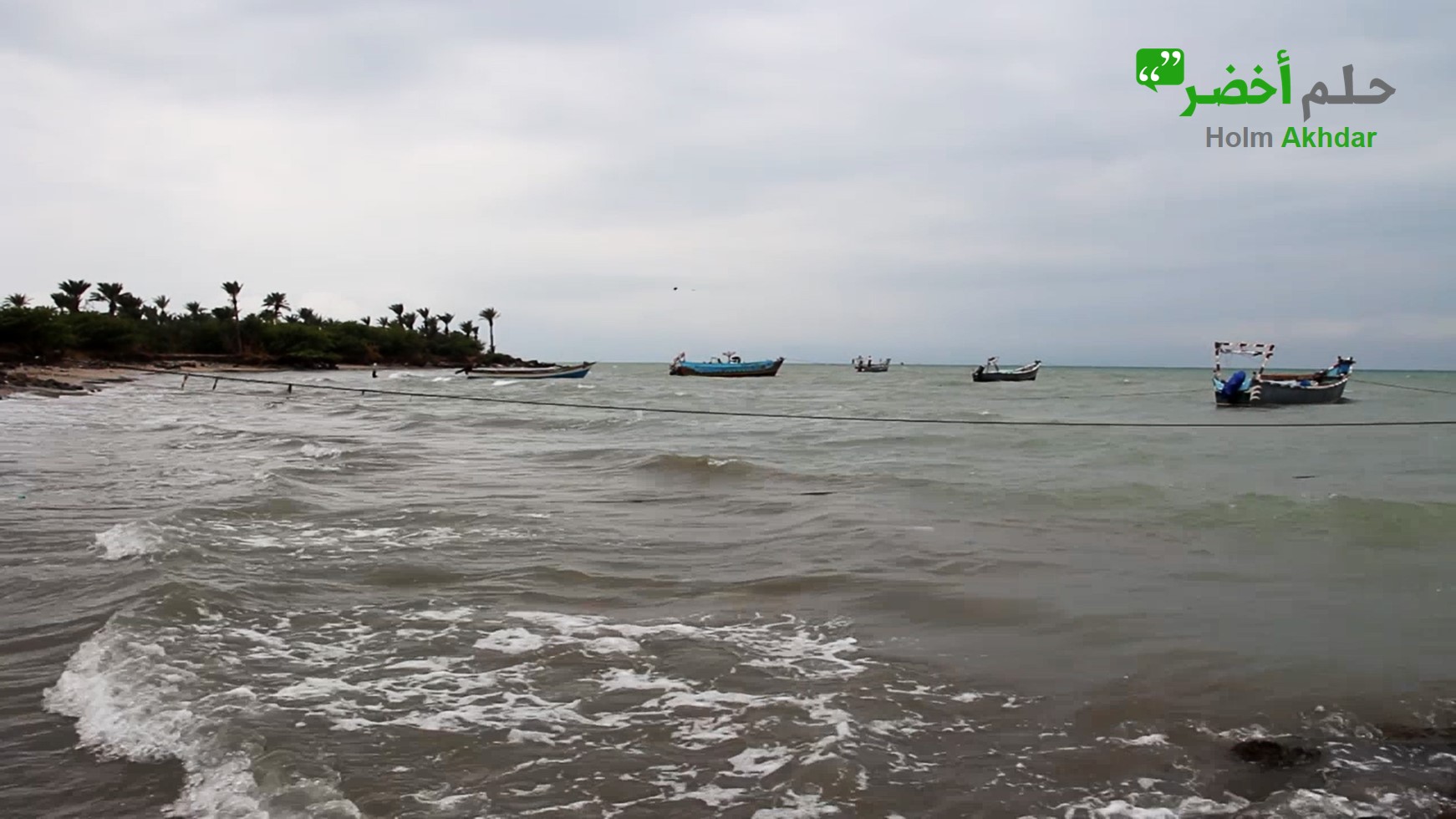
According to the latest official field statistics of the fishing landing centers for the year 2014, the number of Yemeni fishermen in the artisanal fishing sector is about 126,624 working in the fishing landing centers in the coastal regions.
The largest traditional fishing communities in Yemen are concentrated on the western coastline in the Red Sea; mostly in the western Plain of Tehama, where nearly 78,000 fishermen work in fishing landing centers along the coastline from Midi through Al Khokha.
All these fishermen are prone to imminent sea disaster, in the event of about 1,148 million barrels of oil spills from the dilapidated FSO Safer oil tanker, abandoned off the Yemeni coast in the Red Sea.
Eight kilometers away from the port of Ras Isa in Hodeidah governorate, the FSO Safer oil tanker has been anchored for six years without maintenance. The crude oil onboard could cause the most drastic environmental disaster in the world in case it spilled out and mixed with seawater.
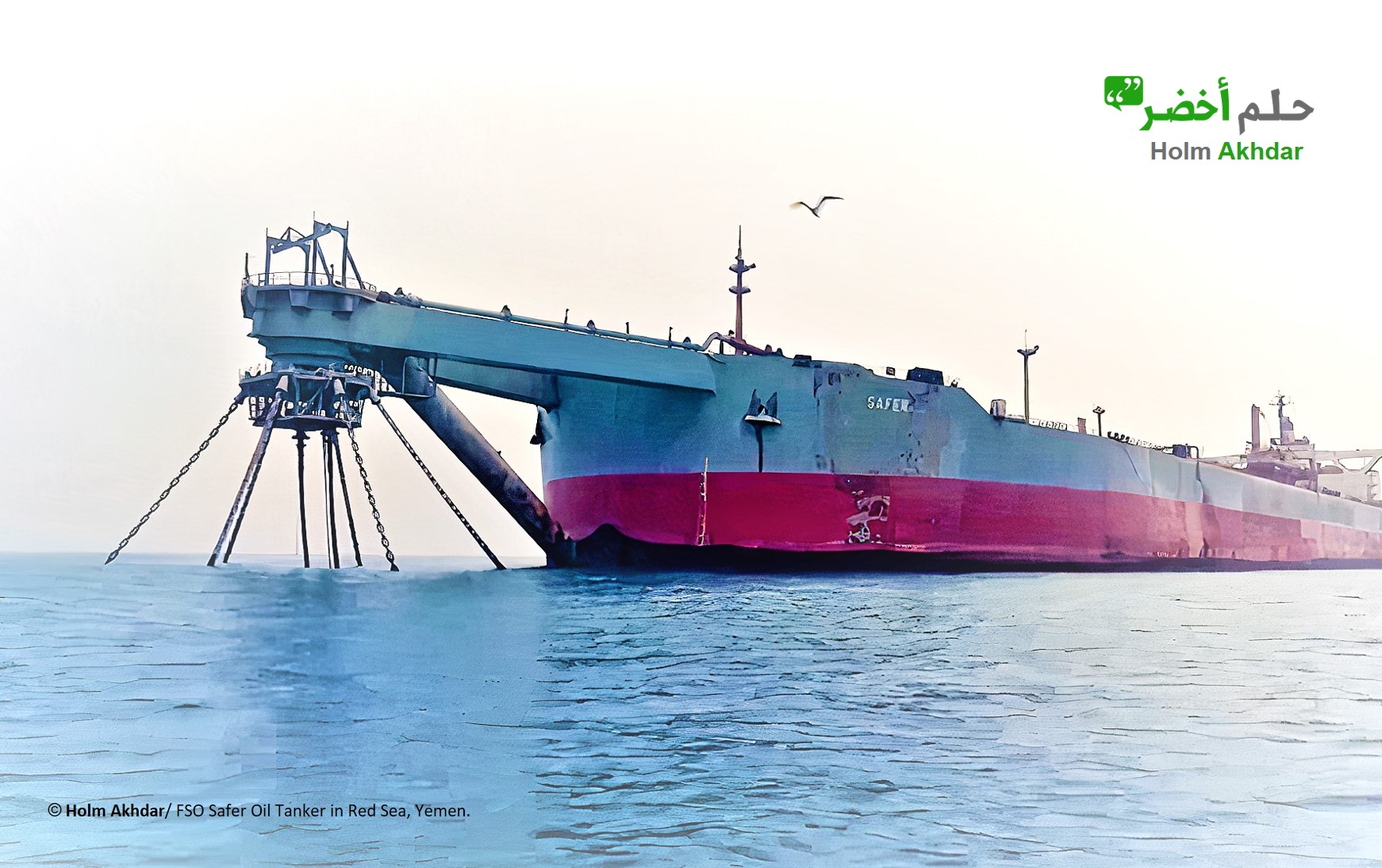
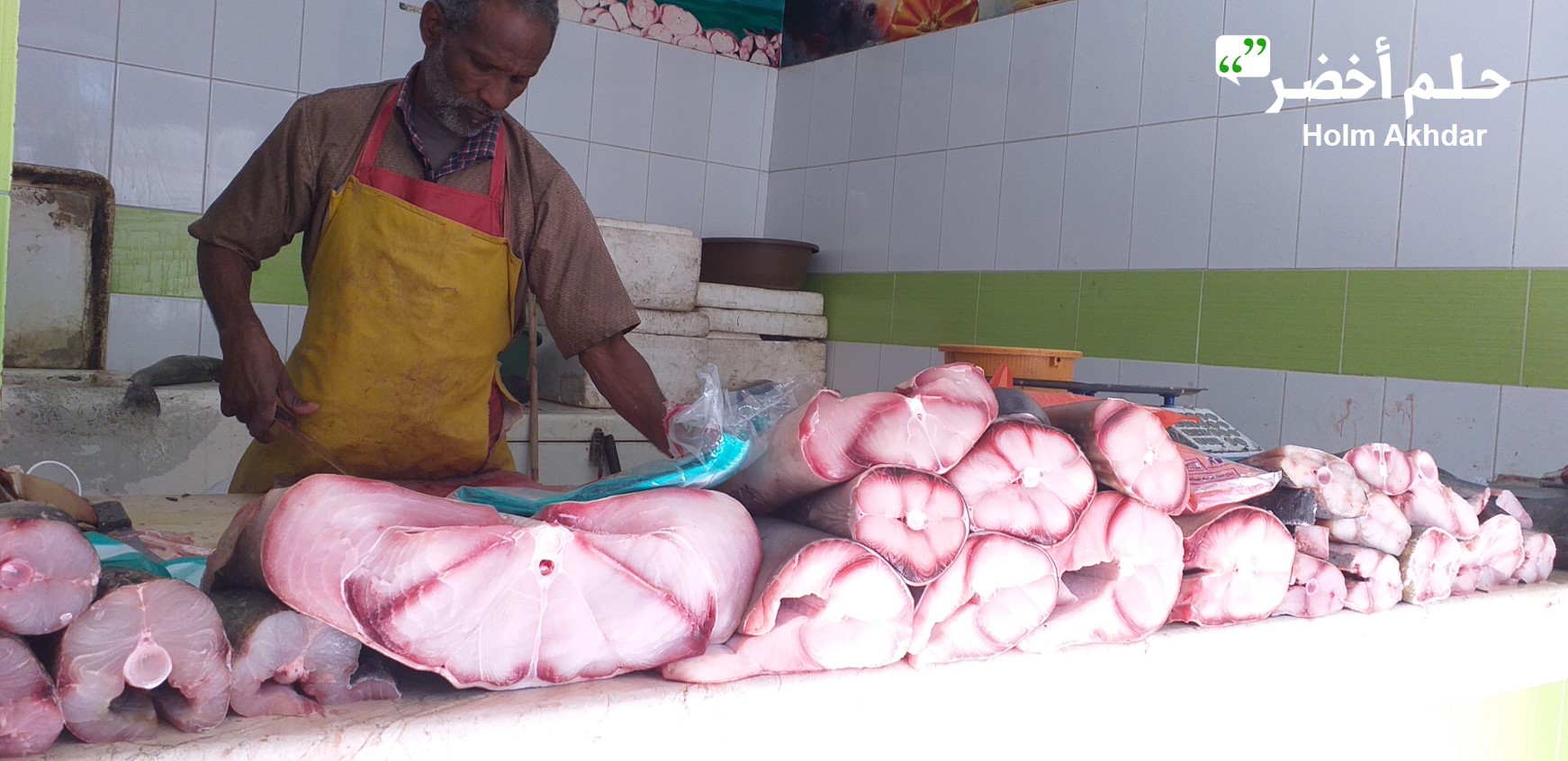
The Fish Sector: 1.5 Million Potentially Affected People
In a statement to Holm Akhdar, Dr. Ali Megheesh, an expert in the Agricultural Research and Extension Authority (AREA), says, “A huge number of people could be affected. The fishermen and restaurant owners who provide jobs for a number of workers would be affected. Also, people who carry out the transportation and those who produce ice might be affected, as well. It is the value chain added to the fish sector.
“Selling fish goes through many processes, and in each process, a large number of workers are involved, and each worker supports a group of individuals who might be affected. In total, the damage might directly affect one million and a half people. Explained Dr. Megheesh.

FSO Safer Disaster: Potential Losses
Forecasts, based on the analysis by the British company Riskware, indicate that 100% of fisheries would be affected by the imminent FSO Safer disaster, and income losses could reach about $ 1.5 billion over 25 years.
According to Riskware analysis, it could take 25 years for fishing stocks to recover. Nearly, 500,000 people working in the fish and seafood industry, plus 1.7 million dependents would be in dire need for food aid.
In the event of an oil spill from the FSO Safer, the port of Hodeidah would be closed for a period of 5-6 months. Relief activities could be directly affected and the current humanitarian crisis would go even worse. Besides, the price of oil derivatives would shoot up by 200% leading to the suspension of all fuel-dependent health, water and sanitation services.
It is estimated that, farmers’ losses may reach 70 million dollars, namely the losses in agricultural production (grains, fruits, vegetables and other cash crops) besides the labor income losses, which could double the food prices, and consequently drive more Yemenis to directly depend on humanitarian aid. Food insecurity would worsen in those areas, as well.
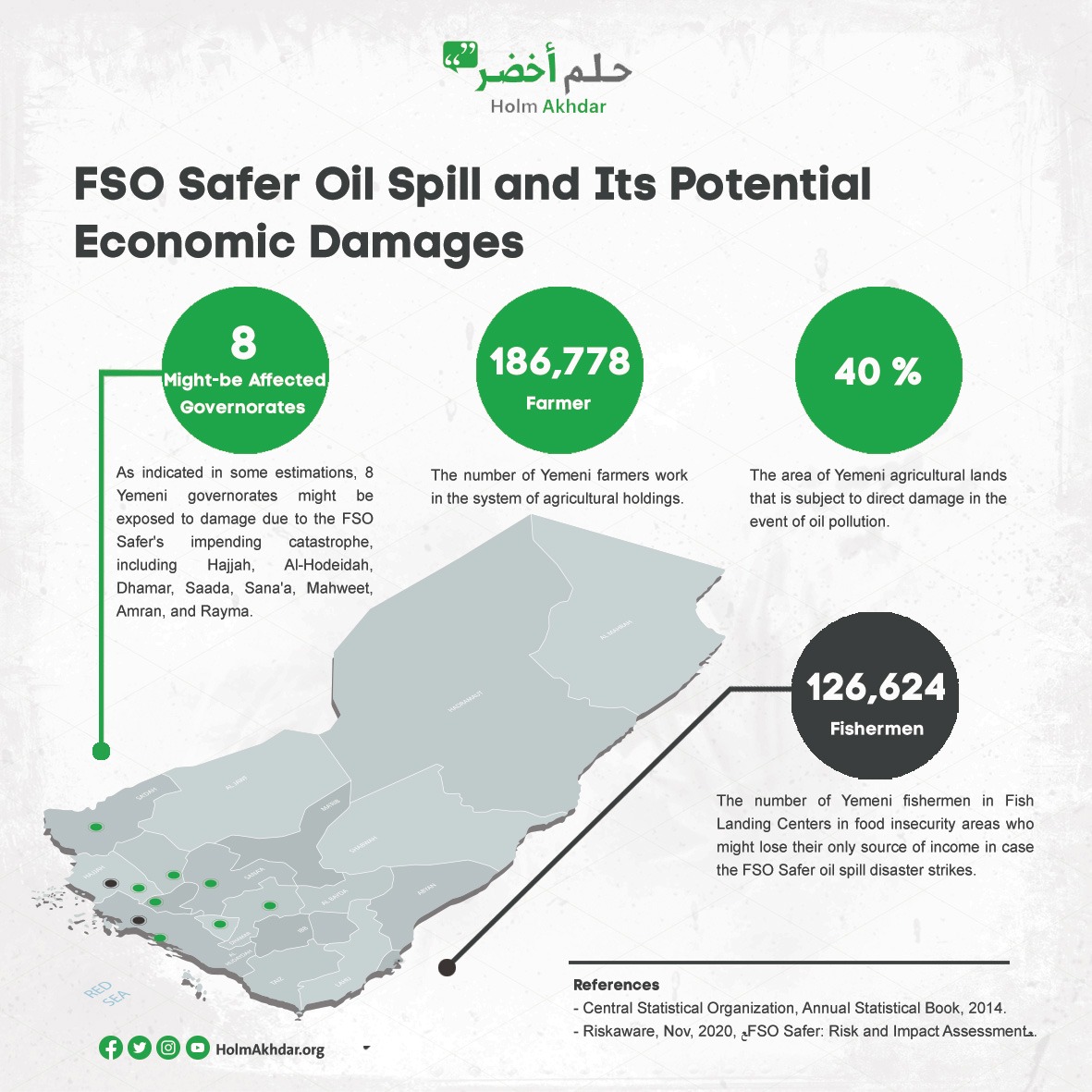
Tehama Farmers: the Most Affected Ones
Tehama (including Hajjah and Al Hodeidah), known as Yemen’s food basket, produces about 40% of the agricultural and livestock production in the country.
Along the coastline of the governorates of Hajjah and Hodeidah, around 186,778 farmers, faced by unremitting challenges and suffering, work in the system of agricultural holdings producing fruits, vegetables, legumes, cash crops, and fodder.
Tehama produces more than 700 thousand tons of fruit, about 110 thousand tons of vegetables and around 90 thousand tons of grains. Imagine the magnitude of the damage in case of oil spills mix with water. Most basic crops, such as bananas and mangoes do not tolerate salinity, let alone the oil pollution. Generally, in the event of any oil spills, all crops will die
People in coastal regions mainly depend on agriculture, fishing and livestock grazing as a source of income and food. They do not have any options to cope with any new shocks.
With a fearful tone, Ahmed Al-Zabidi, a tomato farmer from Tehama, told Holm Akhdar, “We are fully dependent on Allah and then on the farm. We have no other sources of income rather than our farms.”
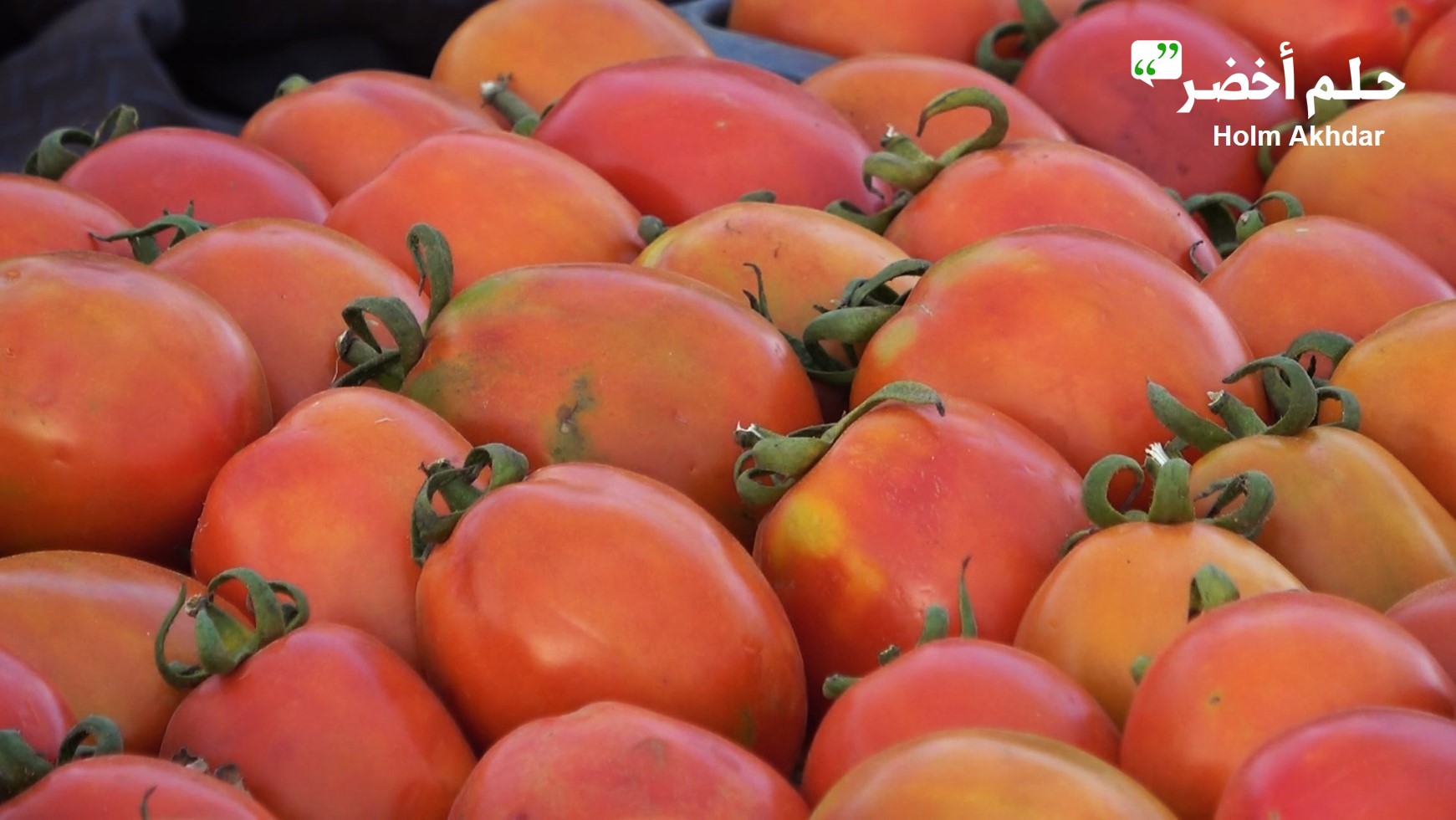

Al Hodeidah: Endangered Food Crops
According to agricultural data, there are about 10,185 hectares cultivated with legume crops in the governorate of Al-Hodeidah, and the agricultural production of legumes in Hodeidah reached about 21,603 tons.
Moreover, the area cultivated with vegetables there is about 9,225 hectares, and vegetable production from the plains of Hodeidah amounts to about 99,347 thousand tons.
Also, Hodeidah’s production of fruit reached 222,952 thousand tons in 2019, topped by mangoes, dates, bananas, papaya, guava, and others. All these crops are cultivated on about 22,909 hectares of agricultural lands.
Additionally, many cash crops are produced in Hodeidah, including sesame, peanuts, tobacco, cotton, and others. As the approximate production of cash crops reached 29,230 thousand tons from an agricultural area of 24,758 hectares.
Saleem Ghanem, an engineer and a farmer from Hajjah governorate- told Holm Akhdar, “If crops were contaminated by the sewage pollution, as it happened in Sana’a, the effects of oil pollution would be even worse. All crops will be demolished (vegetables or fruits). We would also lose livestock. And nothing would remain but an arid desert.”
10 Thousand Water Wells in Danger
Yemeni coastal regions, the largest agricultural production areas in the country, are prone to impending oil pollution, and according to Dr. Ali Megheesh, “All the coastal regions from Abs and Haradh to Bab al-Mandab, about 650 km on the coastline, would be exposed to damage.”
According to specialists, handling oil pollution inside agricultural lands would be a difficult and expensive process. Given the fact that oil-contaminated lands would turn into barren lands where nothing could grow.
In support to this, Dr. Megheesh affirms, “carbohydrates would eliminate the organisms that work on soil fertility, earthworms, and the biological fertilizers of the soil in general. Consequently, all this could have negative impacts on all the plants.”
“All agricultural lands in Tehama depend largely on underground water and flood water. Groundwater covers about 46% of farmers’ needs; however, it has been lately pumped by local farmers in a random way. There are more than 120 thousand wells in Yemen, as listed in the statistics of the Ministry of Water, including 10 thousand water wells in coastal areas, which are prone to risk of oil pollution.”
Dr. Megheesh added, “If oil spilled and mixed with seawater, contaminated water would leak into the groundwater wells. In that case, the agricultural fertile crop-producing soil would be damaged and the population of the area would be displaced.”

What about Livestock and Fodder?
Regarding the number of livestock in Yemen, a Yemeni expert, says, “Livestock number in Yemen is estimated at more than 2 million animals, including, sheep, goats and cows.
Tehama (Hodeidah and Hajjah) produces a huge amount of fodder. As the annual fodder production from Tehama alone reaches more than 600 thousand tons, which is enough to feed livestock all around Yemen.
“In case, Allah forbid, the crude oil spilled and mixed with seawater, an area of about 200 square kilometers (km2 = 100 hectares) would be exposed to destruction. In other words, 20 thousand hectares of agricultural and livestock grazing lands would be damaged.” Continued Dr. Megheesh.
“Impending Safer disaster wouldn’t only strike the coastal regions and Tehama, but rather the whole country would be affected. Furthermore, if an explosion occurred, most of the Yemeni lands would be exposed to damage, and nearly 8 million and a half people or more would be directly affected. He added.
Estimations indicate that about eight Yemeni governorates would potentially be affected by the impending Safer disaster, including the governorates of Hajjah, Hodeidah, Dhamar, Sa’ada, Sana’a, Mahweet, Amran, and Rayma. And it could take a quarter of a decade to recover. Furthermore, heavy oil pollution could extend to the strait of Bab Al-Mandab with some oil pollution might goes beyond the Gulf of Aden.
Economic Activities: Possible Side Effects
In regions with less rainfall like Aden, sea salt is produced through (Al-Memlah), a place where salt is extracted in a traditional way by pumping seawater into basins and exposing it to sunlight until water evaporates leaving a thick layer of salt on the ground of the basins.
Sea salt industry exists along the coast of Aden. However, in the event of the FSO safer disaster, oil pollution will affect all salt production areas causing great losses for workers in this field.
In coastal regions, some electric power plants are operated by using cold seawater that passes through the steam condensation pipes produced by the steam turbines.
Water inlet is occasionally closed following the oil slick as a precautionary measure against machinery damage and in avoidance to the entire and long closure of the plant for the purpose of cleaning any oil-contaminated equipment.
How Could the Damage be Mitigated?
In order to mitigate the effects of the impending FSO Safer disaster, according to Dr. Ali Megheesh, a nationwide campaign to raise public awareness should be immediately launched through mass media and all social media platforms. Also, decision-makers, officials, all employees at public authorities, and all those who work in the humanitarian field should be aware of the effects of the imminent disaster. Besides, a full coordination should be started with all environmental agencies and human rights organizations.
In general, once the FSO Safer disaster occurs, all coastal communities would be prone to the most serious damages, and thus, a new major crisis will arise, exacerbating the existing Yemeni humanitarian crisis, which is described, according to United Nations, as the worst crisis in the world.
(Reporting by: Mohammed Alhakimi. Data: Samah Al-Jaarani, Photography: Issa Al-Rajhi (Hajjah), and Ali Jabour (Al-Khokha).
References:
- Annual Statistics Book for the year 2014, Central Statistics Organization, Yemen.
- Agricultural Statistics Book for the year 2018, Ministry of Agriculture and Irrigation, Republic of Yemen.
- FSO Safer: Risk and Impact Assessment, Riskaware, UK, November 2020.
- Oil Pollution Effects on Social and Economic Activities, ITOPF.

